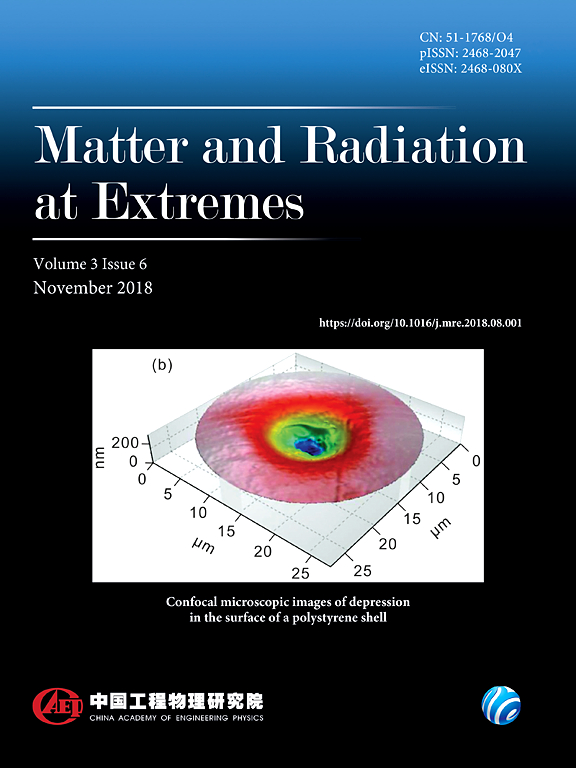PETAL 激光设备上伽马光子产生量的实验测量和电子/正电子产生量的估算
IF 4.7
1区 物理与天体物理
Q1 PHYSICS, MULTIDISCIPLINARY
引用次数: 0
摘要
本文报告了利用高强度 PETawatt Aquitaine 激光器(PETAL)产生的高能光子的首次测量结果。实验是在激光器调试期间进行的。该激光器的能量约为 400 J,强度为 8 × 1018 W cm-2,脉冲持续时间为 660 fs (FWHM)。它被射向一个 2 毫米厚的实心钨靶。高能光子主要产生于在靶前侧产生的等离子体内加速的相对论电子的轫致辐射过程。本文报告了对电子、质子和光子的测量结果。名为 SESAME(Spectre ÉlectronS Angulaire Moyenne Énergie)的光谱仪记录了温度高达 ≈35 MeV 的热电子。名为 SPECTIX(Spectromètre Petal à Cristal en TransmIssion pour le rayonnnement X)的光子光谱仪清楚地探测到了 K 壳和 L 壳。高能光子由 CRACC-X(Cassette de RAdiographie Centre Chambre-rayonnement X)诊断,这是一种轫致辐射炮。轫致辐射加农炮分析在很大程度上取决于对光谱形状所采用的假设。不同形状的光谱可以重现类似的实验数据。为了消除对形状假设的依赖,并便于分析数据,我们对相互作用进行了模拟。为了模拟相关机制,我们使用了一个模拟链,其中包括流体力学模拟、粒子在细胞内模拟和蒙特卡罗模拟。模拟模拟了 PETAL 激光预脉冲在目标前部产生的预等离子体、等离子体内电子的加速、这些电子产生的 MeV 量级光子以及探测器对高能光子束的响应。所有这些工作都使实验数据得以重现。产生的高能光子具有较大的发射角和指数分布形状。除了分析光子光谱外,还研究了正电子的产生。事实上,如果高能光子在固体靶内产生,一些正电子/电子对可能会通过贝特-海特勒过程产生。因此,我们对 PETAL 激光设备可实现的正电子产生量进行了量化。在研究的最后,还研究了利用 PETAL 通过线性布雷特-惠勒过程产生电子/正电子对的可能性。本文章由计算机程序翻译,如有差异,请以英文原文为准。
Experimental measurements of gamma-photon production and estimation of electron/positron production on the PETAL laser facility
This article reports the first measurements of high-energy photons produced with the high-intensity PETawatt Aquitaine Laser (PETAL) laser. The experiments were performed during the commissioning of the laser. The laser had an energy of about 400 J, an intensity of 8 × 1018 W cm−2, and a pulse duration of 660 fs (FWHM). It was shot at a 2 mm-thick solid tungsten target. The high-energy photons were produced mainly from the bremsstrahlung process for relativistic electrons accelerated inside a plasma generated on the front side of the target. This paper reports measurements of electrons, protons and photons. Hot electrons up to ≈35 MeV with a few-MeV temperature were recorded by a spectrometer, called SESAME (Spectre ÉlectronS Angulaire Moyenne Énergie). K- and L-shells were clearly detected by a photon spectrometer called SPECTIX (Spectromètre Petal à Cristal en TransmIssion pour le rayonnnement X). High-energy photons were diagnosed by CRACC-X (Cassette de RAdiographie Centre Chambre-rayonnement X), a bremsstrahlung cannon. Bremsstrahlung cannon analysis is strongly dependent on the hypothesis adopted for the spectral shape. Different shapes can exhibit similar reproductions of the experimental data. To eliminate dependence on the shape hypothesis and to facilitate analysis of the data, simulations of the interaction were performed. To model the mechanisms involved, a simulation chain including hydrodynamic, particle-in-cell, and Monte Carlo simulations was used. The simulations model the preplasma generated at the front of the target by the PETAL laser prepulse, the acceleration of electrons inside the plasma, the generation of MeV-range photons from these electrons, and the response of the detector impacted by the energetic photon beam. All this work enabled reproduction of the experimental data. The high-energy photons produced have a large emission angle and an exponential distribution shape. In addition to the analysis of the photon spectra, positron production was also investigated. Indeed, if high-energy photons are generated inside the solid target, some positron/electron pairs may be produced by the Bethe–Heitler process. Therefore, the positron production achievable within the PETAL laser facility was quantified. To conclude the study, the possibility of creating electron/positron pairs through the linear Breit–Wheeler process with PETAL was investigated.
求助全文
通过发布文献求助,成功后即可免费获取论文全文。
去求助
来源期刊

Matter and Radiation at Extremes
Physics and Astronomy-Atomic and Molecular Physics, and Optics
CiteScore
8.60
自引率
9.80%
发文量
160
审稿时长
15 weeks
期刊介绍:
Matter and Radiation at Extremes (MRE), is committed to the publication of original and impactful research and review papers that address extreme states of matter and radiation, and the associated science and technology that are employed to produce and diagnose these conditions in the laboratory. Drivers, targets and diagnostics are included along with related numerical simulation and computational methods. It aims to provide a peer-reviewed platform for the international physics community and promote worldwide dissemination of the latest and impactful research in related fields.
 求助内容:
求助内容: 应助结果提醒方式:
应助结果提醒方式:


